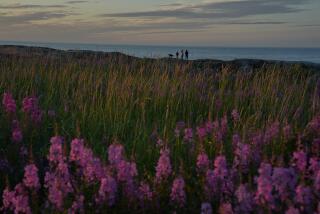Old Halifax in the Maritimes Takes On New Look
- Share via
HALIFAX, Canada — “We’re coming up next!”
This is the message being sent from the historic provinces of Eastern Canada to potential visitors from the United States.
A $4.8-million promotional campaign for autumn is timed to capitalize on the interest in travel to all of Canada generated by Expo 86 in Vancouver, British Columbia, which has given the far west of this country its greatest tourism year.
The Expo momentum will be followed by a tourism boost from the ’88 Winter Olympics in Calgary, where many of the new ski facilities are ready to be enjoyed this winter.
The autumn campaign for the eastern provinces will tie into the national theme aimed at the United States: “Canada, the World Next Door.” The joint venture by the Canadian government, the provinces and the private tourism sector, will utilize TV, newspapers, magazines and radio.
Goal of the campaign will be to create a feel of new destinations in provinces where much of North American history began.
Here in the Maritimes along the North Atlantic coast, Nova Scotia preserves the Latin name given to the colony of New Scotland in 1621 when King James VI of Scotland, who was also James I of England, set up a colonial grant of all the land between New England and Newfoundland.
237th Year
We arrived here in time to help celebrate Halifax Natal Day on Aug. 4, commemorating the 237th birthday of the capital city of Nova Scotia. We found ourselves amid multimillion-dollar restoration projects.
Along Spring Garden Road, we walked where Winston Churchill walked during his wartime visit in 1943. The street and his statue harmonize with the renaissance on the waterfront of this first English town in Canada.
Closer to the waterfront, we walked past Province House and Founders Square where Charles Dickens walked in 1842.
In the Fairview District of the city, we read the headstones on the graves of Titanic passengers and crew who died when the ship struck an iceberg and sank in 1912, only 650 miles off this Maritime coast.
We stepped from our room in the new Halifax Sheraton on the waterfront to go aboard Bluenose II, a seagoing replica of one of the maritime racing world’s most famous sailing vessels.
From our room, we looked down at the restored Privateers’ Warehouse, which once received booty captured on the high seas and where now there is a pub on the first floor, casual dining on the second and elegant dining on the third.
We were introduced to the community by a guide whose family roots are deep in the history of Halifax.
Along Herring Road, Clyde Chambers, who has sold his own business interests and keeps busy by working as a guide through the tourist office in the city, told us we were on Chambers Hill, where his grandparents had owned considerable property and where a house they built still stands.
Local History
Near the waterfront restorations, he showed us the rebuilt area where his father’s family had been away from home for a few hours on Dec. 16, 1917, when the World War I munitions ship Mont Blanc, loaded with 4,000 tons of explosives, collided with another vessel out in the Narrows of the harbor. The explosion took more than 2,000 lives.
At the hilltop Citadel, overlooking the city and the harbor, Chambers pointed out where he was stationed as a young soldier before sailing to the front lines of Europe during World War II.
The ramparts of the Citadel were started by Cornwallis when he arrived in 1747 with some 2,500 men, women and children to found Halifax and offset French control over the approaches to the St. Lawrence River.
Looking down on the harbor now full of sailboats, our guide recreated for us the somber days when it was filled with merchant ships gathering for the North Atlantic convoys during World War II. The new Maritime Museum on the waterfront focuses on the city’s maritime heritage, and is only one of many museum experiences offered by the city and its five universities.
The Citadel’s fortifications have never been involved in hostile gunfire; its story is told to visitors in a series of slide and sound shows.
From the hill, Chambers took us down to a tour of the restaurant rows, theaters, galleries, museums and parks. He introduced us to the fishing, boating and harbor cruising marinas, the public tennis courts and golf course. The wooded parks are laced with trails for walking and biking. Among the flower beds of Public Gardens, close to the heart of the city, swans glided across a pond.
Seaview Park is dedicated to the blacks who came here from the United States as runaway slaves before the Civil War, and as the homeless and jobless after that war. The city is a composite of many immigrants--French, English, Dutch, Scottish, German, Irish, as well as English Loyalists from south of the border who settled here because of America’s Revolutionary War.
Around the old Town Clock and its tower, students sketched and painted the scenes around them. The clock was a gift to the city from the Duke of Kent, who led a lively, romantic life here when he headed the garrison between 1794 and 1800; he later became the father of Queen Victoria.
Jazz Trio Playing
At the south end of the Grand Parade, St. Paul’s Church first opened in 1750. On Sunday afternoon we listened to a jazz trio playing nearby.
At the corner of Argyle and George streets is the town’s earliest school building, opened in 1818. It later became the Victoria School of Art and Design, directed by Anna Leonowens (better known as the governess for the King of Siam in the “King and I”). Now the Five Fishermen seafood restaurant is part of the restored Victoria school building.
Close to the Province House, which Dickens called “a gem of Victorian architecture,” is a statue of Joseph Howe, who fought and won a battle for freedom of the press in early Halifax.
At Hollis and Salter streets, the ironstone Brewery, which opened in 1836 and capped its last bottle of beer in 1971, has been restored as pubs, a cocktail lounge, shops and restaurants.
On other historic streets we came upon contemporary centers of the performing arts such as theNeptune Theatre and the Halifax Metro Center complex. The dinner-theater offered by the Historic Feast Co. in Simon’s Warehouse features actors, actresses and vocalists who took us back to Halifax of the 1840s as they served a multi-course dinner.
We went on from Halifax and Nova Scotia to discover what’s new in Newfoundland and in the mini-world of Prince Edward Island.
The renaissance in Halifax is also taking place across the harbor in the smaller community of Dartmouth.
The Maritimes have maintained a slow but steady tourism growth during the last few years.
This summer, up to July 31, nearly 228,000 autos had crossed the border into Nova Scotia, compared to 225,000 in the same period last year. The autumn season already “looks pretty strong,” according to tourism officials.
More than a hundred festivals and cultural highlights are scheduled each year in and around Halifax. Events coming up during the weeks ahead include the 9th International Town Crier’s Championship Sept. 13 at the Historic Properties on the waterfront. Town criers from around the world will compete in three categories: best dressed, best cry and loudest cry.
Gathering of Clans
Plans are under way for the 1987 International Gathering of the Clans, set to begin in Halifax in June and to continue through much of the summer. Everyone from around the world with a bit of Scottish heritage, or maybe just with a love of bagpipes and the ballads of Robert Burns, is invited to join the festivities.
With the Canadian dollar currently valued at about 73 cents to the U.S. dollar, the nightly weekend rate for a waterfront room at the Halifax Sheraton is U.S. $56. Double accommodations in a wide range of Halifax hotels, inns and bed & breakfast homes start at $30. Our evening of dinner and theater at the Historic Feast Co. cost about $18 per person.
This summer Air Canada is celebrating its 50th anniversary with Four-Season-Fares that save up to 70% off regular coach fares. With 30 days advance purchase, the round-trip Los Angeles/Halifax fare is as low as $393. For information on the Maritimes, contact the Division of Tourism, Canadian Consulate General, 510 West 6th St., Suite 712, Los Angeles 90014, phone (213) 627-9511.
More to Read
Sign up for The Wild
We’ll help you find the best places to hike, bike and run, as well as the perfect silent spots for meditation and yoga.
You may occasionally receive promotional content from the Los Angeles Times.





